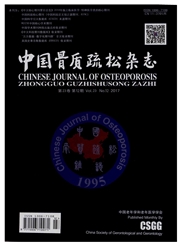

 中文摘要:
中文摘要:
目的探讨双能X线吸收测量法(DXA)髋几何力学参数在预测髋部脆性骨折风险中的应用价值。方法髋部骨折女性患者41例(年龄52.3-89.d岁)及正常对照组259例(年龄28.2~88.3岁)行DXA扫描获取股骨颈骨密度(femurneckBMD,FN-BMD)及髋几何力学分析参数,包括股骨颈横截面惯性矩(CSMI)、股骨颈横截面面积(CSA)、截面模数(sM)、曲率比率(BR)、颈宽度(FNW)、髋轴长(HAL)、股骨颈干角(NSA),并计算股骨近端强度指数(FSI)。利用受试者工作特征曲线(ROC)分析相关变量判定髋部骨折的效能。结果校正年龄、身高、体重、BMI混杂因素,髋部骨折组与非骨折组间FN-BMD差异有显著性意义(P〈0.01),髋部骨折组FSI、SM、CSMI、CSA较非骨折组低(P均〈0.05),而BR、FNW、NSA、HAL较非骨折组高(P均〈0.05);当校正FN-BMD时,只有FSI、NSA及HAL在两组间差异仍有统计学意义(P均〈0.05)。控制混杂因素,FNBMD与FSI(r=0.339)、BR(r=-0.291)、SM(r=0.644)、CSMI(r=0.425)、NSA(r=-0.291)呈轻-中度相关性,FN-BMD与CSA相关密切性最好(r=0.908,P〈0.001)。FN—BMD、FSI、HAL、NSA判定髋部骨折的ROC曲线下面积(AUC)分别为0.794±0.031、0.790±0.032、0.652±0.049、0.684±0.049。FN-BMD及FSI判定髋部骨折的效能相仿(P=0.9128)。FN-BMD联合FSI判定髋部骨折的AUC为0.844±0.039,较FN-BMD大(P〈0.05)。结论FSI独立于FN-BMD起作用,可作为判断骨质疏松性髋部骨折的有用因子。FN-BMD联合FSI可以提高预测髋部骨折风险的能力。
 英文摘要:
英文摘要:
Objective To investigate the predictive value of the hip osteoporotic fractures from the hip structure hnalysis using dual energy X-ray absorptiometry (DXA). Methods Forty-one women with hip fractures ( aging from 52.3 to 89.4 years old) and 259 health controls (aging from 28.2 to 88.3 years old) were selected. The femoral neck bone mineral density (FN_BMD) was detected using DXA. The geometry parameters of the proximal femur, including cross-sectional moment of inertia ( CSMI), cross-sectional area (CSA) , section modulus (SM), buckling ratio (BR) , the femur neck width (FNW) , the hip axis length (HAL), and the neck shaft angle (NSA) were also obtained. The femur strength index (FSI) was calculated. The predictive value of the correlated variables was analyzed using ROC curve areas (AUCs). Results After adjusting for the confounding factors, including age, height, weight, and BMI, the significant difference of FNBMD betweem fracture group and non-fracture group was observed (P 〈 0. 01 ). The hip structural parameters such as FSI, SM, CSMI, and CSA in the hip fracture group were lower than those in non-fracture group, while BR, FNW, NSA, and HAL were higher ( P 〈 0.05 ). After adjusting for FN_BMD, the remaining significant difference of FSI, NSA, and HAL was observed between the two groups ( P 〈 0. 05 ). After controlling for the confounding factors, FN_BMD showed a low-moderate correlation with FSI ( r = 0. 339) , BR ( r = - 0. 291 ) , SM ( r = 0. 644) ,CSMI ( r = 0. 425), and NSA ( r = - 0. 291 ), and the relationship between FN_BMD and CSA was the strongest ( r =0. 908, P 〈 0. 001 ). AUC for the hip fracture prediction from FN BMD, FSI, HAL, and NSA was 0. 794±0. 031, 0. 790±0. 0321 0. 652 ±0. 049, and 0. 684± 0. 049, respectively. FSI best predicted the risk for each fracture and did not differ significantly from FN BMD. AUC for FNBMD combining with FSI was 0. 844 ± 0. 039, which was significantly higher tha
 同期刊论文项目
同期刊论文项目
 同项目期刊论文
同项目期刊论文
 The temporal characterization of marrow lipids and adipocytes in a rabbit model of glucocorticoid-in
The temporal characterization of marrow lipids and adipocytes in a rabbit model of glucocorticoid-in Characterizing venous vasculatures of hepatocellular carcinoma using a multi-breath-hold two-dimensi
Characterizing venous vasculatures of hepatocellular carcinoma using a multi-breath-hold two-dimensi 期刊信息
期刊信息
